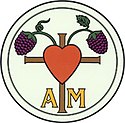Community of True Inspiration
| Part of a series on the |
| Schwarzenau Brethren (the German Baptists or Dunkers) |
|---|
 |
| Background |
| Doctrinal tenets |
|
| People |
| Groups |
Defunct groups |
| Related movements |
The Community of True Inspiration, also known as the True Inspiration Congregations,
History
Inspirés
From the time of the
Pott brothers
The Inspirés influenced three brothers surnamed Pott who lived in Halle until they were exiled and went to Hanau and Wetteravia east of Frankfurt in 1714. The Pott brothers were several of many Pietists who had come to the area to take advantage of the religious tolerance of the counts of Isenburg-Eisenberg. There, they gave what many understood as divinely-inspired ecstatic speeches in a trance-like state. They sometimes experienced uncontrollable jolting motions of their entire bodies while they were preaching, which was understood as verification that they were seized by a divine spirit. Their message was a call to repentance and awakening.[3]
Early Inspirationalist movement
Many were drawn to the Potts, and the group that gathered around them emerged as a distinct group in the late autumn of 1714. This group is known as the Inspirationalists. Soon, others began preaching in a similar style and experienced similar convulsions. Among these other early leaders were Eberhard Ludwig Gruber, Johann Friedrich Rock, and Ursula Meyer of Thun.[3]
Everywhere the Inspirés and Inspirationalists went, communities gathered around them. However, political freedom was very limited in this era, and the Inspirationalists were routinely banished and were unable to find a place in Europe they could permanently settle. Their religious practices, including
Gruber stayed for a time with the community of
Decline and renewal
Their religion continued to grow until Gruber and Rock's deaths, but subsequently declined until a reawakening sparked by Michael Krausert, who preached for a revival and had much support.[7]
Migration to North America
In the 1840s, renewed religious restrictions and requirements from political rulers prompted the Inspirationalists to migrate as a group to North America. Their first settlements were near
Official membership was 1,534 in 1925, and was more than a thousand as late as the 1980s.[9]
Legacy
The Community of True Inspiration Residence was listed on the National Register of Historic Places in 2013.[10]
Notable members
- Conrad Beissel, who joined in 1715 in the German Palatinate,[6] and later founded the Ephrata Cloister
- Barbara Heinemann Landmann
- Christian Metz
See also
- Pentecostal
References
- ^ Nordhoff 1875, p. 25.
- ^ The Brethren Encyclopedia, Volume 1. Brethren Encyclopedia, Inc. 1983.
Community of True Inspiration, a Radical Pietist movement in 18th-century Germany which became a successful communal society in 19th-century America.
- ^ a b c Lehmann, Van Horn Melton & Strom 2016, p. 96f.
- ^ a b Lehmann, Van Horn Melton & Strom 2016, p. 98ff.
- ^ Durnbaugh 1966.
- ^ a b Bowman 1995, p. 9.
- ^ Shambaugh, Bertha. Amana That Was and Amana That Is. Iowa City: The State Historical Society of Iowa, 1932.
- ^ a b c Lehmann, Van Horn Melton & Strom 2016, p. 101.
- ^ a b Thearda.com – Data from the National Council of Churches' Historic Archive.
- ^ "National Register of Historic Places Listings". Weekly List of Actions Taken on Properties: 6/24/13 through 6/28/13. National Park Service. 2013-07-05.
Sources
- Bowman, C.F. (1995). Brethren Society: The Cultural Transformation of a "Peculiar People". Center Books in Anabaptist Studies. Johns Hopkins University Press. ISBN 978-0-8018-4905-3.
- Durnbaugh, D.F. (1966). Brethren Beginnings: the Origins of the Church of the Brethren in Early Eighteenth-century Europe (Thesis). University Microfilms.
- Lehmann, H.; Van Horn Melton, J.; Strom, J. (2016). Pietism in Germany and North America 1680–1820. Taylor & Francis. ISBN 978-1-351-91120-7.
- Nordhoff, Charles (1875). "The Amana community". The Communistic Societies of the United States. ISBN 978-1-4065-5041-2.
- Statistical Profile of Amana at ARDA
Further reading
- F. Alan DuVal. Christian Metz: German-American Religious Leader & Pioneer. Ed. Peter Hoehnle. Penfield Books, 2005. ISBN 1-932043-33-0
- Ensign, Chauncey David (1955). Radical German Pietism (c. 1675—c. 1760) (PhD). ProQuest 301993876.
- The Amana Colonies, a National Park Service Discover Our Shared Heritage Travel Itinerary
External links
- Amana Church: The Community of True Inspiration Archived 2017-07-30 at the Wayback Machine (official website)
- Catechism in German
- Catechism in English
- Hymnal in German
